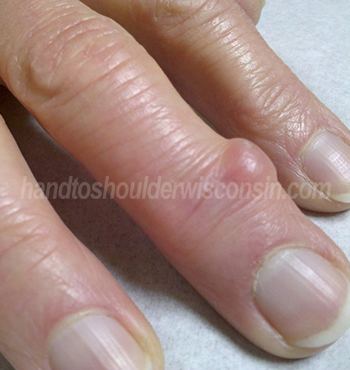Concerned you may have a ganglion cyst? Looking for treatment options or just more information on this type of cyst? The orthopedic doctors at Hand to Shoulder Center of Wisconsin specialize in the focused care of the upper extremities. Fingers, hands, wrists, forearms, elbows and shoulders, our orthopedic team has the experience and knowledge to provide you with the answers you need and the service you deserve. Learn more about ganglion cysts and your treatment options, and call Hand to Shoulder Center of Wisconsin today for more information.

Figure 1: Ganglion cyst – wrist
A ganglion cyst is a fluid-filled mass that lies beneath the skin near a joint or tendon. They can develop in any joint in the body but the most common occurrence of this tumor-like mass develops in the dorsal (back side) and palm side of the wrist. Other locations include the finger, palm of hand, wrist, elbow, shoulder, hip, knee, ankle and foot (Fig. 1). Ganglion cysts typically form within deep tissue as one or a cluster of smaller cysts connected by a common stalk. The common stalk feeds fluid into the tumor-like mass.
The exact reason why a ganglion cyst develops is unknown, however, it is thought to be formed when the natural joint lubricating fluid (synovial fluid) leaks or is pushed out into the common stalk, depositing fluid into a pouch-like sac. The fluid is sticky, colorless and a jellylike substance. Ganglion cysts are typically harmless and non-cancerous; however, depending on the location and size of the ganglion, they can cause irritation and/or moderate pain.

Figure 2: Ganglion cyst – finger
Ganglion cysts can grow or decrease in size, and in some cases they even disappear completely, only to possibly reappear at a future date. They often appear as small, smooth bumps that are firm, round and at times, spongy to the touch (Fig. 2). The overall size of a ganglion cyst can vary.
Treatment options for a Ganglion Cyst
Some ganglion cysts disappear with time while others grow larger and some remain docile. For all mass related bumps of the upper extremity, consulting with a hand and upper extremity physician is highly recommended. At Hand to Shoulder Center of Wisconsin, the physician conducts a thorough physical evaluation of the sight in question. Symptoms and medical history facts are discussed. An ultrasound may be ordered to determine whether the mass is fluid-filled (cystic) or if it is solid. The ultrasound will also display if an artery or blood vessel is causing the bump. If a diagnosis is undetermined at this time, fluid may be aspirated from the cyst and further examined. Magnetic resonance imaging (MRI) is another option in diagnosing the ganglion cyst.
Depending on the location, irritation and pain level of the cyst, the patient has non-surgical and surgical options for treatment. If pain is not present, it may be suggested to simply do nothing and be watchful of the mass. If irritation and pain develops, aspirating the cyst or a surgical procedure to remove the common stalk and pouch-like sac can be discussed.
Aspirating is the art of injecting a syringe needle into the cyst and pulling or draining the fluid out. At this time, a steroid compound (anti-inflammatory) may be injected. Aspirating will reduce swelling and alleviates pressure; however, it is likely that the cyst will reappear.
Surgery is the removal of the ganglion cyst. Surgery can be performed as an outpatient or in-office procedure depending on the size and location of the ganglion cyst. Surgery can be scheduled at Woodland Surgery Center, adjacent to the clinic, or one of the three Fox Valley hospitals or our Green Bay office. A local or regional anesthesia can be used depending on your discussion with the surgeon; a small incision (cut) is made and the ganglion cyst and common stalk are identified and removed. Stitches are applied and the area is covered with a dressing-like wrap.
Depending on the severity and location of the cyst, stiffness and soreness may be present following surgery. Nonetheless, movement and use of the joint is recommended. To encourage a full recovery, our physicians provide you with information and some specific exercises to help you with movement.
In some cases, it is possible that your ganglion cyst may return. However, it is less likely to return when surgery is performed.
